This is a prompt I recently had in Art History.
Dear Art Expert,
The other day, I went to an art museum with a friend. We saw a large painting by the artist, Jackson Pollock. It looked like a bunch of scribbles! My friend even said, “a monkey could have painted that!” Why is this painting so important? I just don’t get it. If I throw paint on a canvas, will I be famous too?
Confused in Asheville
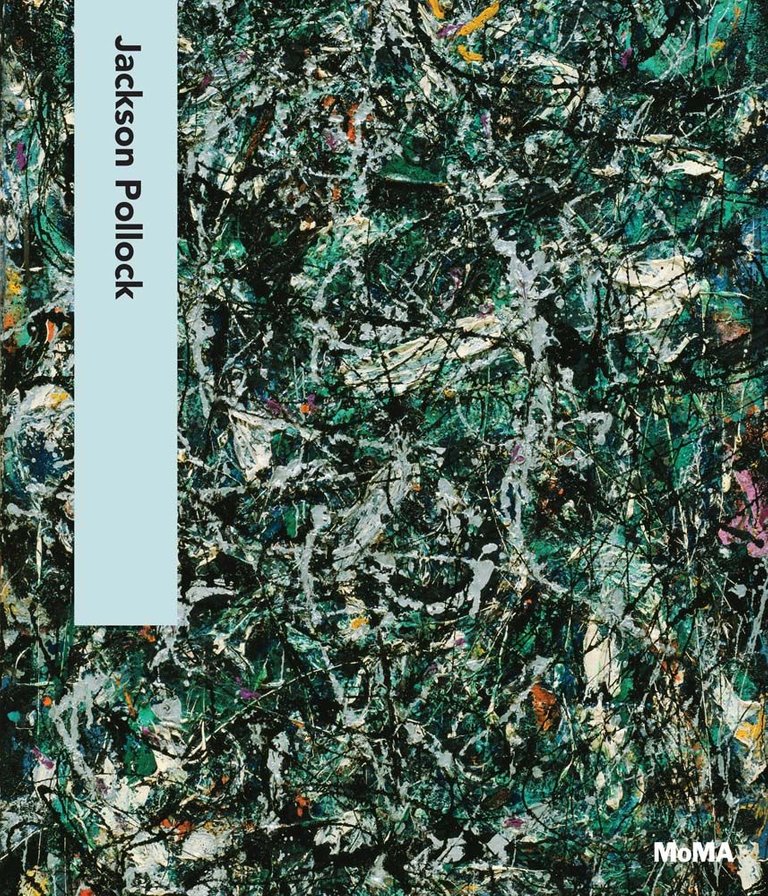
Dearest Confused in Asheville,
It is difficult to understand and appreciate the abstract drip paintings of Jackson Pollock, without looking at both his own progression as an artist and, also, taking a larger step back and looking through the perspective of the whole world leading up to and encompassing his generation of Abstract Expressionists. While European artists portrayed motifs of conflict and war, such as Picasso’s 1941 Massacre in Korea , and communist and other propaganda used high contrast, simplified realism, there was a general trend of American artists to depoliticize art. These Americans began moving away from making figurative works that could be thought of as representative of anything specific—which, in turn, liberated them from society and broke their connection to previous history of art.
Along with turning away from paintings with figurative subjects, these artists were using their newfound freedom to experiment with materials and techniques. This was, in some ways, illustrative of the art community’s fascination with a variety of other cultures’ arts. Leading up to the mid-1940’s, several museums had displayed exhibits showcasing native American, African, and other “folk” arts. Though promoted as “primitive” art, the contemporary Abstract Expressionist artists were not only noticing these shows, but beginning to emulate the techniques and styles of these artisans.
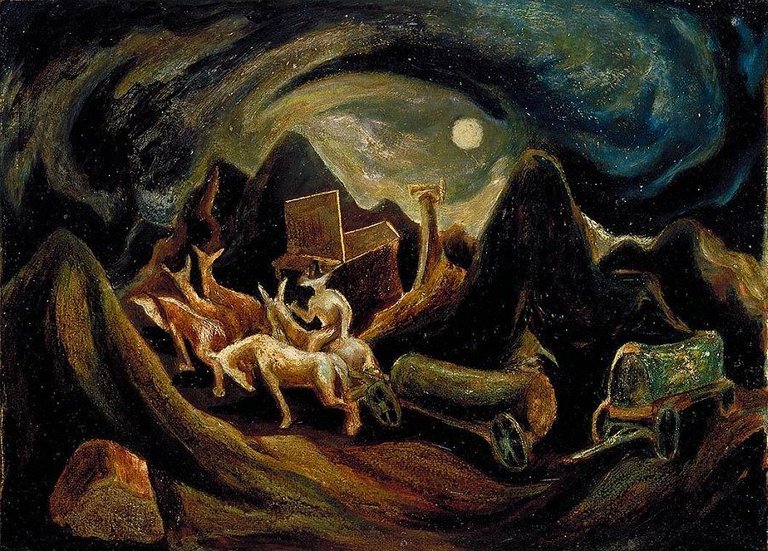
During the 1930’s, Jackson Pollock was supported by a public arts program, the WPA, and he exemplified the ideal American painter. The program was looking to promote the American image and, as he hailed from the western states and was painting its regional scenic imagery, he fit their desired image perfectly. Pollock’s earlier paintings, such as Going West, from 1935, with abstracted forms of a covered wagon and saloon, painted in a limited palette, were partially influenced by the WPA’s stipend and partially by his instructor at the time—
“Regionalistic” painter Thomas Hart Benton, who was painting somewhat similar abstracted scenery of the southwest. Pollock, as if he knew he was destined for something greater was not happy with doing these type of paintings, so after parting ways with Benton, he was free to explore other techniques and styles.
Pollock continued developing his own unique artistic approach leading up to World War II, and while he was keeping some representation of figure, his works were highly influenced by those “primitive” artists. He was more focused on symbolism, mark-making, and sigil-esque automatic drawings—such as what was recommended to be done for psychoanalytically therapeutic reasons by his alcohol recovery therapist. This “automatism” was a technique being employed by several of the Abstract Expressionists, merging the sketch and the drawing—allowing the piece to have a life of its own. For Jackson Pollock, this new technique would begin the transformation of his work, progressing into the drip paintings he is now most famous for.
In the early 1940’s, Pollock was able to find a benefactor in Peggy Guggenheim, who owned a small gallery showing contemporary artists, Peggy Guggenheim’s Art of This Century Gallery. Galleries such as Guggenheim’s were places where the artists could not only show their work, but commune with others and foster a community among themselves. Through exhibiting and frequenting these small establishments to view others’ work, the artists were able to exchange ideas without the intervention of the viewer or critic. This environment of artists influencing each other, versus paying homage to patrons, was another factor leading to the expanding of their respective repertoires of innovation in each of their art.
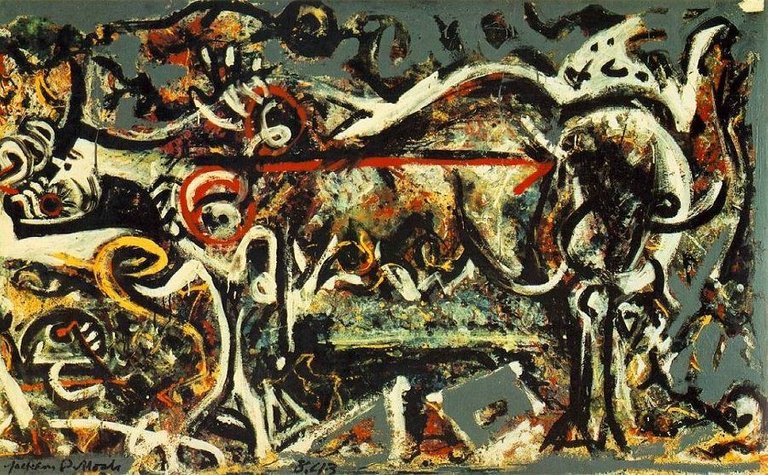
During this time, Jackson Pollock painted She-Wolf and Guardians of the Secret. Both of these paintings are reminiscent of the “primitives” style of layering subjects, with totem-like figures, but each also contains evidence of the direction he was headed—each having very expressive dancer-ly paint strokes. Pollock himself said, “She-Wolf came into existence because I had to paint it. Any attempt on my part to say something about it, to attempt an explanation of the inexplicable, could only destroy it.” His use of automatism was beginning to give his paintings a life of their own.
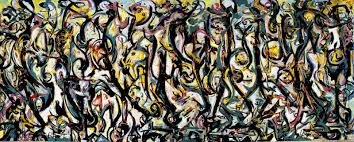
Mural was one of Pollock’s first extra-large exclusively Abstract Expressionistic pieces. Commissioned by Peggy Guggenheim to be completed by the time she was scheduled to host a dinner party, the myth is that Pollock completed it in one sitting, the day before it was to be hung for the party. In truth, he probably painted it over the course of a few weeks, but the myth allows us to spotlight the way time constraints and monetary motivations can have an effect on the course of an artist’s history. Mural shows some of the first evidence of Pollock throwing paint onto a canvas and within a few years, he would paint Full Fathom Five, one of his first full-canvas drip paintings.
While the artists of the post-war United States, including Jackson Pollock, were moving away from representative paintings, experimenting with mediums and techniques, and emulating native cultures, the critics of the art world were struggling to keep up the innovations at this quick pace. In such, the critics had to find a new way to look at, understand, and categorize this “new” (i.e. not European produced) art coming out of America. Though Pollock had been doing his drip paintings and others had been using highly expressionistic techniques for years, it took the art critic Harold Rosenberg until 1952 to coin the term “action painting,” both to describe the work and the way it was made. As Rosenberg said, “The big moment came when it was decided to paint…just to PAINT—The gesture on the canvas was a gesture of liberation from Value—political, aesthetic, moral.” As the critics had finally noticed, to these artists, the process was more important than the end product.
Just as the artists had to learn how to liberate themselves through their creativity, the art critics had to re-think how they would term their formal analysis of the expressionists works. Besides naming this completely new style of putting paint on canvas (or whatever else was available) “action painting”, they also had to come to terms with this new “all over composition” style of Pollock’s work. “All over composition” means that in his paintings, there was no focal point, no figure, no ground, no definitive shapes, or anything that would draw the viewer’s attention from anything but the entirety of the piece (or the studying its individual elements). The typical elements of critique—form, composition, color, etc.—are secondary to the motion of the moment shown in the paint, the encounter with the materials, and the liberation and self-creation of the art. Art critics were now asked to psychologically analyze the work, along with evaluating it based on its aesthetic quality. Jackson Pollock happened to be the most outlier of all of these stylistic advances happening and maybe that is what made him such a good poster boy for this artistic “revolution.”
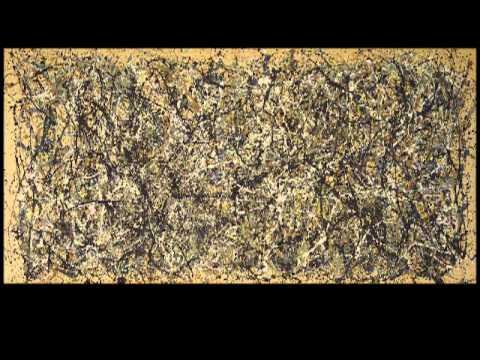
So, Confused in Asheville, I hope you can see that by the time Jackson Pollock painted one of the several of his paintings titled One, in 1950, the face of the art world had experienced and was going through so many changes, even the entrenched art critics could barely keep up. His success was not purely based on what your friend says “a monkey could have painted.” His success was built from years of innovation, production, promotion, inspiration, alcohol, and cigarette ashes—all of which are imbedded in his works. The paint on the canvas may not be the most aesthetically pleasing to everyone’s eye, heart, or soul, but the journey Pollock and other Abstract Expressionists made from (anti)response to communist propaganda, all the way to pure emotive “action painting,” propelled the art world eternities forward, in less than one generation. That is what makes Jackson Pollock’s paintings so important—being in the right place, at the right time, around the right people, doing the things that no one else had.
Kudos to you @puddles, that is lovely article you throw out there and the photo ar really fantastic
Thank you!
Well said @puddles, I become endlessly tired of trying to explain to people why works such as these are so important and why they are given the credits they have been. People forget when looking at art that all art needs to be viewed in context of the artists personal journey and the time in which it was produced and although a work may not be yo your personal style or taste to give respect for works such as these that opened new avenues for artists that didn't exist before.
Thank you! I know that I have been guilty of wondering “huh?” about some artists or works. You are right, it isn’t just about the aesthetics—there is so much that goes into the making of some pieces (time, culture, personal), that it is hard to comprehend without knowing all the pieces.
Not that dissimilar from Jonas Gerard honestly.
But, he did it first.
Also, he wasn’t known to be a sexual predator, just a womanizer.
It was a different time!
This post has received a 1.92 % upvote from @boomerang thanks to: @puddles